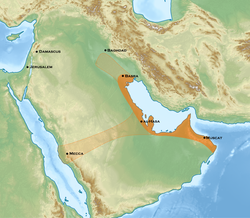
Back قرامطة Arabic القرامطه ARZ Qərmətilik Azerbaijani Ҡарматтар Bashkir Кармати Bulgarian কারামাতিয়ান Bengali/Bangla Càrmates Catalan قەرمەتی CKB Qarmaten German Karmatoj Esperanto
Qarmatians قرامطة | |||||||||
|---|---|---|---|---|---|---|---|---|---|
| 899–1077 | |||||||||
 Qarmatians under Abu Tahir al-Jannabi in 930. | |||||||||
| Capital | Al-Ahsa | ||||||||
| Religion | Isma'ilism | ||||||||
| Demonym(s) | Qarmatian | ||||||||
| Government | Theocracy | ||||||||
| Ruler | |||||||||
• 894–914 | Abu Sa'id al-Jannabi | ||||||||
• 914–944 | Abu Tahir al-Jannabi | ||||||||
• 944–970 | Ahmad Abu Tahir | ||||||||
• 968–977 | Al-Hasan al-A'sam | ||||||||
• 970–972 | Abul Kassim Sa'id | ||||||||
• 972–977 | Abu Yaqub Yousuf | ||||||||
| Historical era | Islamic Golden Age (4th Islamic century) | ||||||||
| 765 | |||||||||
| 899 | |||||||||
| 930 | |||||||||
• al-Isfahani proclaimed to be the Mahdi | 931 | ||||||||
• Black Stone returned | 952 | ||||||||
• Defeated by the Abbasids | 976 | ||||||||
| 1077 | |||||||||
| |||||||||
| Qarmatians | |
|---|---|
| قرامطة | |
| Founder | Abu Sa'id al-Jannabi |
| Dates of operation | 899–1077 |
| Active regions | Bahrayn, Mesopotamia, Najd, Hejaz, Levant, Egypt |
| Ideology | Isma'ilism Extremism Socialism[1] Islamic socialism[1] Utopian socialism[1] |
| Opponents | Abbasid Caliphate Fatimid Caliphate Uyunid Emirate Seljuk Empire |
| Battles and wars | Capture of Bahrayn (899) Battle of Hama (903) Sack of Basra (923) Hajj caravan raid (924) Invasion of Iraq (928) Sack of Mecca (930) Invasions of Egypt (971) Overthrow of the Qarmatians (1058–1077) |
| Part of a series on Islam Isma'ilism |
|---|
 |
|
|
The Qarmatians (Arabic: قرامطة, romanized: Qarāmiṭa; Persian: قرمطیان, romanized: Qarmatiyān)[a] were a militant[3][4] Isma'ili Shia movement centred in Al-Ahsa in Eastern Arabia, where they established a religious—and, as some scholars have claimed, proto-socialist or utopian socialist[5][6][7]—state in 899 CE. Its members were part of a movement that adhered to a syncretic branch of Sevener Ismaili Shia Islam,[2] and were ruled by a dynasty founded by Abu Sa'id al-Jannabi, a Persian from Jannaba in coastal Fars.[8][9] They rejected the claim of Fatimid Caliph Abdallah al-Mahdi Billah to imamate and clung to their belief in the coming of the Mahdi, and they revolted against the Fatimid and Abbasid Caliphates.[10][2]
Mecca was sacked by a Qarmatian leader, Abu Tahir al-Jannabi,[11] outraging the Muslim world, particularly with their theft of the Black Stone and desecration of the Zamzam Well with corpses during the Hajj season of 930 CE.[12]
- ^ a b c Fahes, Fadi (2018). ASocial utopia in tenth century Islam the Qarmatian experiment. California State University, Dominguez Hills. p. 68.
- ^ a b c "Qarmatian | Meaning, Attack, Beliefs, & History". Encyclopædia Britannica. Retrieved 1 July 2021.
- ^ Mumayiz, Ibrahim A. (2006). Arabesques: Selections of Biography and Poetry from Classical Arabic Literature. Coronet Books Incorporated. p. 39. ISBN 978-90-441-1888-9.
- ^ Jr, Everett Jenkins (11 November 2010). The Muslim Diaspora (Volume 1, 570-1500): A Comprehensive Chronology of the Spread of Islam in Asia, Africa, Europe and the Americas. McFarland. p. 98. ISBN 978-0-7864-4713-8.
- ^ Clark, Malcolm (9 August 2019). Islam For Dummies. John Wiley & Sons. ISBN 978-1-119-64304-3.
- ^ Thompson, Andrew David (31 October 2019). Christianity in Oman: Ibadism, Religious Freedom, and the Church. Springer Nature. p. 47. ISBN 978-3-030-30398-3.
- ^ Corm, Georges (2020). Arab Political Thought: Past and Present. Oxford University Press. p. 96. ISBN 978-1-84904-816-3.
- ^ Carra de Vaux & Hodgson 1965, p. 452.
- ^ Madelung 1983.
- ^ de Blois, François (1986). "THE 'ABU SAʿIDIS OR SO-CALLED "QARMATIANS" OF BAHRAYN". Proceedings of the Seminar for Arabian Studies. 16: 13–21. ISSN 0308-8421. JSTOR 41223231.
- ^ Mecca's History, from Encyclopædia Britannica.
- ^ Cite error: The named reference
Glassewas invoked but never defined (see the help page).
Cite error: There are <ref group=lower-alpha> tags or {{efn}} templates on this page, but the references will not show without a {{reflist|group=lower-alpha}} template or {{notelist}} template (see the help page).